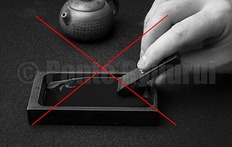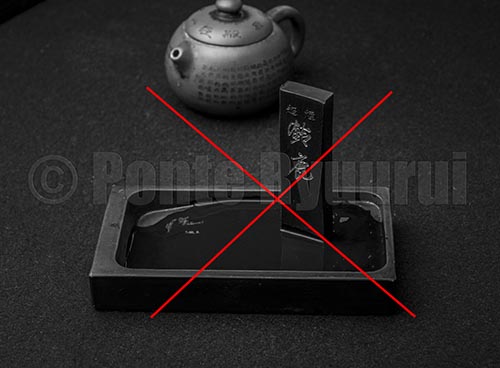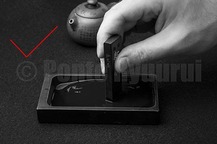|
Regardless of how much ink (墨) you have ground for your Chinese or Japanese calligraphy practice, or how long you intend to write, I would advise you not to dip the entire brush tuft inside the ink pool. Chinese calligraphy is supposed to be written with the tip of the brush (1/3rd of the brush tuft length). Naturally, there are exceptions. For example, modern calligraphy or any other over-expressive calligraphy styles, will invite you to writing with the whole tuft. Nevertheless, for calligraphy practicing (i.e. copying Chinese or Japanese calligraphy masterpieces), majority of writing will be executed with the 1/3rd of the brush tuft. Although I will be discussing the anatomy of the Chinese calligraphy brush separately (note: there are types of brushes used in Japanese calligraphy that differ in construction from the Chinese ones), I will mention here that the ink should be loaded into the space located inside the brush tuft, which is formed by longer and shorter hair arrangement. It is called "the stomach" (腹). The ink is stored there and it is being released during writing. The stomach of the brush is located in the upper half of the brush tuft. Thus, writing calligraphy with the lover 1/3 to 1/2 of the brush tuft, makes sense. Brush should not drip with ink, unless intentionally done so. It will case the paper to blur excessively. A paper that is too wet will tear much easier, too. As shown in the video (below), apply ink onto the brush by rotating and tapping the brush tuft against the inkstone (硯) grinding surface, in the direction of the brush tuft hair arrangement. Once loaded, the brush should be sharp and pointy, not crooked, and the tuft surface ought to be smooth and round (no sticking out hairs). Ink grinding is an art. Chinese calligraphy ink (墨) is traditionally prepared by grinding it with water on the inkstone. It looks easier than it really is. Here are few basic, but also very important things to bear in mind. The things you should n o t do: 1. Do not leave the ink in the pool of ground ink on the inkstone. One of the ingredients of ink used for Chinese calligraphy is animal glue (although other types of glue are also used in its production). If you leave an inkstick on the inkstone grinding surface (i.e. the "ink temple" / 墨堂), as shown in the middle picture below, it may stick to the inkstone and ruin it permanently. 2. Avoid grinding ink at steep angles (as shown in the left-hanbd side picture, below). Although some calligraphers prefer to grind ink at a steep angle to the grinding surface of the inkstone, it is much easier to control the pressure during grinding while the ink is ground. The old saying goes: "wield the brush with the power of a warrior, and inkstick with the power of a withered man". Finally, when the inkstick becomes too short to be held by hand, you can glue two types of the same ink together. If you grind ink at a steep angle, there is no way to join both pieces. 3. Do no press the inkstick with force against the inkstone temple. If you think it will help you to grind ink faster, then Chinese calligraphy is not for you. By doing so, you may not only ruin the inkstone, but also damage ink. The chipped particles of ink may then ruin a brush, or even tear paper. Also, the finest the particles of the ground ink, the easier it will be to write. So, be like a withered man. 4. Do not use a lot of water. A few drops will do. Grinding ink is a time consuming task, and it supposed to be a meditation, not a race. Again, if you are impatient, or you seek quick solutions, then Chinese calligraphy is not for you. Using too much water will result in lower quality ink liquid. Preparation if ink is all about consistency, colour and dryness / wetness of the ink. You need to consider the paper type you use, the brush (types and size), what script you write in, and also your personal preference. All those come with practice. The more you grind, the more you know how to grind. If you rush, you will not learn anything. The above video shows the proper way of ink grinding. Each ink (even the same type from the same factory) has different proprieties. There are all kinds of ink and all kinds of inkstones. Both are closely related. It is important to keep searching for a match between the ink stick and the inkstone. It is a quest on which every calligrapher is alone.
|
Categories
All
AuthorPonte Ryuurui (品天龍涙) Archives
August 2020
|




 RSS Feed
RSS Feed
